Tobera airfield was an aerodrome located near Tobera, near Keravat, East New Britain, Papua New Guinea. The airfield was constructed by the imperial Japan during World War II (during August 1943). Tobera was later neutralized by Allied air bombing from 1944. The airfield was abandoned after the cessation of hostilities.

Saburō Sakai was a Japanese naval aviator and flying ace of the Imperial Japanese Navy during World War II. Sakai had 28 aerial victories, including shared ones, according to official Japanese records, though he and his ghostwriter Martin Caidin claimed much higher numbers.

The Mitsubishi A5M, formal Japanese Navy designation Mitsubishi Navy Type 96 Carrier-based Fighter (九六式艦上戦闘機), experimental Navy designation Mitsubishi Navy Experimental 9-Shi Carrier Fighter, company designation Mitsubishi Ka-14, was a WWII-era Japanese carrier-based fighter aircraft. The Type number is from the last two digits of the Japanese imperial year 2596 (1936) when it entered service with the Imperial Navy.
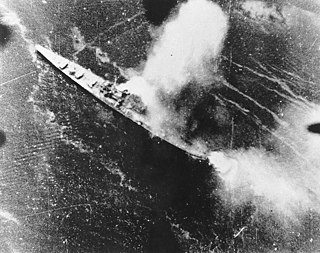
The bombing of Rabaul in November 1943 was an air attack conducted by the Allies of World War II upon a cruiser force at the major Japanese base of Rabaul. In response to the Allied invasion of Bougainville, the Japanese had brought a strong cruiser force down to Rabaul from Truk, their major naval base in the Caroline Islands about 800 miles north of Rabaul in preparation for a night engagement against the Allied supply and support shipping. Allied carrier- and land-based planes attacked the Japanese ships, airfields, and port facilities on the island of New Britain to protect the Allied amphibious invasion of Bougainville. As a result of the Rabaul raids, the Japanese naval forces could no longer threaten the landings. The success of the raid began to change the strongly held belief that carrier-based air forces could not challenge land-based air forces.
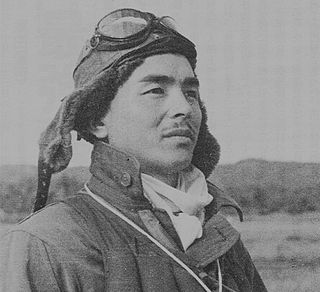
Lieutenant Junior GradeHiroyoshi Nishizawa was a Japanese naval aviator and an ace of the Imperial Japanese Navy Air Service during World War II. Nishizawa was known to his colleagues as 'the Devil' for his breathtaking, brilliant, and unpredictable aerobatics and superb control of his aircraft while in combat. He was a member of the Tainan Kōkūtai's famous "clean up trio" with fellow aces Saburō Sakai and Toshio Ōta and would see action in the New Guinea campaign as well as in the aerial battles over Guadalcanal and over the Solomon Islands. He was killed in 1944 during the Philippines Campaign while aboard an IJN transport aircraft. It is possible that he was the most successful Japanese fighter ace of the war, reportedly telling his last CO that he had achieved a tally of 86 or 87 aerial victories- post war he was linked with scores of 147 or 103, but both of these scores have been considered inaccurate.
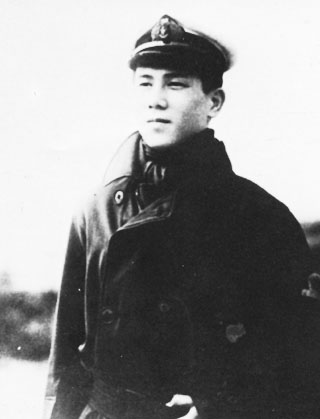
Lieutenant CommanderJunichi Sasai was a Japanese naval aviator and fighter ace of the Imperial Japanese Navy during World War II. Sasai was killed leading his fighter squadron during an attack on Henderson Field during the Battle of Guadalcanal.

Yap International Airport is an airport on Colonia, the main island of the State of Yap in the Federated States of Micronesia. The airport is serviced by United Airlines from Guam. Pacific Missionary Aviation makes periodic trips to the outer island airfields of Ulithi Atoll and Fais Island. Woleai airfield is currently closed for repairs.
Vunakanau Airfield was an aerodrome located near Vunakanau, East New Britain, Papua New Guinea. The airfield was constructed as a Royal Australian Air Force aerodrome and consisted of an unpaved single runway during World War II. The airfield was captured during the battle of Rabaul in 1942 by the Imperial Japanese and was extensively modified and expanded. Vunakanau was later neutralized by Allied air bombing in May 1944.

The Tainan Air Group was a fighter aircraft and airbase garrison unit of the Imperial Japanese Navy (IJN) during the Pacific campaign of World War II. The flying portion of the unit was heavily involved in many of the major campaigns and battles of the first year of the war. The exploits of the unit were widely publicized in the Japanese media at the time, at least in part because the unit spawned more aces than any other fighter unit in the IJN. Several of the unit's aces were among the IJN's top scorers, and included Hiroyoshi Nishizawa, Saburō Sakai, Junichi Sasai, Watari Handa, Masaaki Shimakawa, and Toshio Ōta.
The 4th Air Group was a land-based bomber aircraft unit of the Imperial Japanese Navy Air Service (IJNAS) during the Pacific campaign of World War II. The air group was redesignated as the 702nd Air Group on 1 November 1942.

Operation I-Go was an aerial counter-offensive launched by Imperial Japanese forces against Allied forces during the Solomon Islands and New Guinea campaigns in the Pacific Theater of World War II. Taking place from 1–16 April 1943, Japanese aircraft—primarily from Imperial Japanese Navy units under the command of Admirals Isoroku Yamamoto and Jinichi Kusaka—attacked Allied ships, aircraft, and land installations in the southeast Solomon Islands and New Guinea. The goal of the operation was to halt the Allied offensives to give Japan time to prepare a new set of defenses in response to recent defeats in the Guadalcanal campaign and in New Guinea at Buna–Gona, Wau, and the Bismarck Sea.
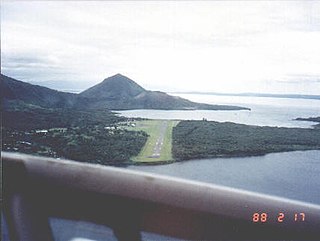
Lakunai Airfield, later known as Rabaul Airport, was an aerodrome located near Rabaul, East New Britain, Papua New Guinea. It was located at the foot of Tavurvur volcano, near Matupit Island. The airport was destroyed by the 1994 eruption that destroyed the town of Rabaul and subsequently a new airport was built and opened at Tokua, on the opposite side of the Rabaul caldera. The former airport was located at 04°13′S152°11′E.

Kerevat Airfield was an aerodrome located near Kerevat, East New Britain province, Papua New Guinea. Situated on the northern coast, it was 13 miles (21 km) south west of Rabaul. The airfield was constructed by the Imperial Japanese in World War II during September 1943. Kerevat Airfield was neutralized by Allied Powers' air bombing from 1944, who ran missions on the airfield between June 20, 1943, and May 16, 1944. The airfield was abandoned after the cessation of hostilities; however, the airstrip is still visible.
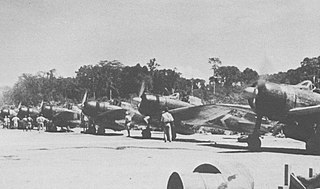
Kahili Airfield, also known as Buin Airfield, was an airfield located near Buin, Bougainville Island, Papua New Guinea.
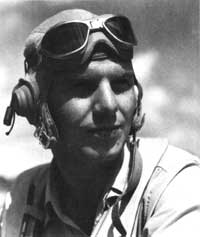
Donald Nathan Aldrich was a United States Marine Corps Reserve captain and World War II flying ace. With 20 victories, Aldrich was the fifth-highest-scoring Marine Corps ace of the war. He joined the Royal Canadian Air Force after the United States Army Air Corps refused him because he was married. Aldrich became an instructor pilot and transferred to the United States Marine Corps in late 1942. He joined VMF-215 in the Solomon Islands campaign in June 1943, flying the Vought F4U Corsair. Aldrich added to his 20 victories in three combat tours with six probables, the highest total number of probables in the Marine Corps. Postwar, Aldrich continued to serve in the Marine Corps and was killed in a 1947 plane crash.
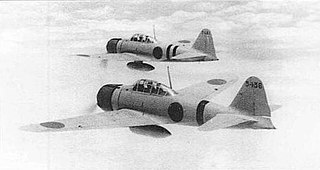
The 12th Air Group was a unit of the Imperial Japanese Navy Air Service (IJNAS) during the Second Sino-Japanese War that operated mainly in the campaigns in the Central China.
The 6th Air Group was a unit of the Imperial Japanese Navy Air Service (IJNAS) during the Pacific War that was involved in Battle of Midway and then extensively in the Guadalcanal Campaign and Solomon Islands Campaign. The air group was redesignated as the 204th Air Group on 1 November 1942.
The 2nd Air Group was a unit of the Imperial Japanese Navy Air Service (IJNAS) during the Pacific War that was involved in the Guadalcanal Campaign, Solomon Islands Campaign and New Guinea Campaign. The air group was redesignated as the 582nd Air Group on 1 November 1942.
The Takao Air Group was a unit of the Imperial Japanese Navy Air Service (IJNAS) during the Pacific War that was involved in the Philippines campaign, Dutch East Indies campaign, air raids on Australia, and the Guadalcanal Campaign. The air group was redesignated as the 753rd Air Group on 1 October 1942.
John Malcolm Smith was an American combat pilot who was a United States Navy fighter ace during World War II. He was credited with shooting down 10 Japanese aircraft during the last two years of the Pacific War. Smith received his law degree in 1950 and served in the United States Naval Reserve until his retirement in 1972.